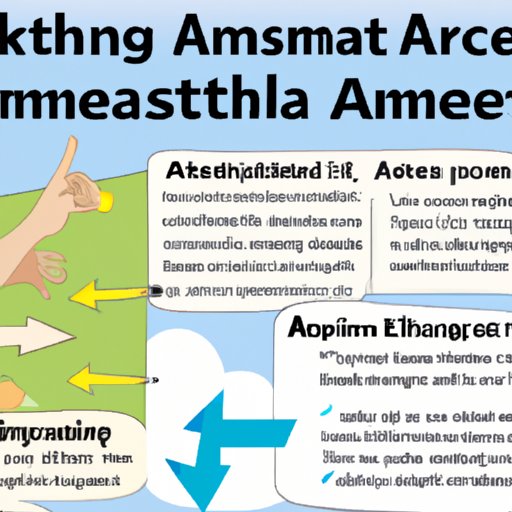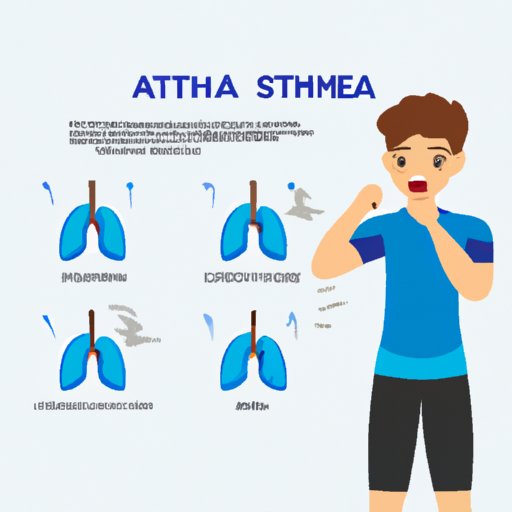Introduction
Exercise induced asthma is a type of asthma that is triggered by physical activity. It affects up to 90% of people with asthma, making it a fairly common occurrence. While exercise can be beneficial for those with asthma, it can also be a trigger for an asthma attack. Understanding the causes and symptoms of exercise induced asthma is key to managing the condition and preventing attacks.

Exploring the Causes and Symptoms of Exercise Induced Asthma
Exercise induced asthma is caused by a combination of factors, including allergens, temperature and humidity, and air pollutants. Allergens such as pollen, dust mites, and pet dander can trigger an asthma attack in those with exercise induced asthma. Temperature and humidity can also play a role, as cold, dry air is known to cause asthma attacks. Air pollutants such as ozone, sulfur dioxide, and nitrogen dioxide can also irritate the airways and lead to an asthma attack.
Common symptoms of exercise induced asthma include chest tightness, coughing, wheezing, and shortness of breath. These symptoms are usually temporary and resolve after the person stops exercising. However, if left untreated, exercise induced asthma can lead to more serious complications.

How to Prevent and Manage Exercise Induced Asthma
The best way to prevent and manage exercise induced asthma is to avoid triggers. This means avoiding allergens, exercising in moderate temperatures and humidity levels, and avoiding air pollutants when possible. In addition, it is important to take medications before exercising, as this can help reduce the severity of an attack.
Warming up before exercising is also important, as it helps the body adjust to the increased exertion. Stretching and light aerobic activity can help prepare the lungs for more strenuous activity. Additionally, it is important to stop exercising if any symptoms of an asthma attack develop, as continuing to exercise can make the symptoms worse.

The Benefits of Exercise for Those with Exercise Induced Asthma
Despite the potential risks of exercise induced asthma, regular physical activity can actually have positive effects on those with the condition. Regular exercise can improve lung function, which can help reduce the severity of asthma attacks. Additionally, exercise can help improve overall quality of life, as it can increase energy levels and reduce stress.
Exercise can also help increase stamina, as it strengthens the muscles and makes them more efficient. This can make it easier to engage in physical activities without feeling winded or tired. Finally, regular exercise can help boost the immune system, which can help reduce the frequency of asthma attacks.
Treatment Options for Exercise Induced Asthma
There are a variety of treatment options available for exercise induced asthma. Prescription medications such as inhaled corticosteroids and bronchodilators can help reduce inflammation and open up the airways. Over-the-counter medications such as antihistamines and decongestants can also be used to treat symptoms. Additionally, alternative treatments such as acupuncture, yoga, and breathing exercises can be used to help manage symptoms.
Understanding the Link Between Exercise and Asthma
It is important to understand the link between exercise and asthma in order to properly manage the condition. Physical activity can act as a trigger for an asthma attack, as it can increase the amount of allergens and pollutants in the air. Allergic reactions can also occur due to the increased exposure to allergens. In addition, other factors such as temperature and humidity can also trigger an asthma attack.
How to Identify an Exercise Induced Asthma Attack
If you are experiencing any of the symptoms of an asthma attack, it is important to stop exercising immediately. Common symptoms of an asthma attack include chest tightness, wheezing, coughing, and shortness of breath. If you think you may be having an attack, it is important to seek medical attention as soon as possible.
Conclusion
Exercise induced asthma is a type of asthma that is triggered by physical activity. It is important to understand the causes and symptoms of this condition in order to properly manage it. Avoiding triggers, taking medications, and warming up before exercising can help prevent and manage exercise induced asthma. Additionally, regular exercise can provide many benefits for those with this condition, such as improved lung function, increased stamina, and enhanced quality of life. There are also a variety of treatment options available for exercise induced asthma, including prescription medications, over-the-counter medications, and alternative treatments. By understanding the link between exercise and asthma, it is possible to identify and manage an asthma attack.
(Note: Is this article not meeting your expectations? Do you have knowledge or insights to share? Unlock new opportunities and expand your reach by joining our authors team. Click Registration to join us and share your expertise with our readers.)
